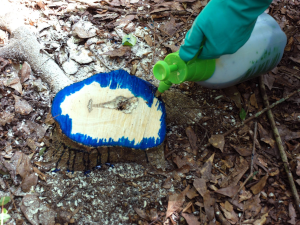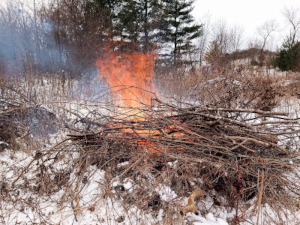Winter Activities at Oakhurst

Cutting Brush, Brush and Brush
With the growing season over, there is little else to do in winter other than cut woody brush; but don't worry, this is hardly a small task. You may even find yourself wishing winter was a little longer in order to finish the job we started in the fall. Honeysuckle and buckthorn are the big two we deal with, but other species include callery pear, autumn olive, burning bush, glossy buckthorn, and Japanese barberry. The work is simple - cut everything down to the ground, and then treat the stumps with herbicide.
Priority workzone: F2

Burning Brush Piles
When you cut down a lot of shrubs, you inevitably have to deal with all the generated brush. In the past the District would sweep by and chip everything, but with an increase in volunteers, the workload became too much for the operations staff to handle. So instead, we let it go up in flames.
In order the burn, piles must be compact and located away from anything that could be accidently ignited. There must also be a layer of snow on the ground to keep the fire from spreading.

Winter Sowing
Any seed harvested in the fall is broadcast in the winter. Most native seed requires stratification, that is, a prolonged period of moist cold temperatures before it can to germinate. This is a basically a survival technique to prevent seeds from sprouting during a warm spell in the fall only to be killed by the winter.
I normally wait until December or January to sow in order to reduce seed predation by insects and birds, by which time most have died or migrated away; although I am not sure it makes that big of a difference.

 Volunteering
Volunteering Safety
Safety Wildlife
Wildlife Newsletter
Newsletter